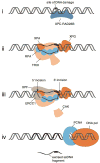Mammalian nucleotide excision repair proteins and interstrand crosslink repair
- PMID: 20658645
- PMCID: PMC3017513
- DOI: 10.1002/em.20569
Mammalian nucleotide excision repair proteins and interstrand crosslink repair
Abstract
Although various schemes for interstrand crosslink (ICL) repair incorporate DNA recombination, replication, and double-strand break intermediate steps, action of the nucleotide excision repair (NER) system or some variation of it is a common feature of most models. In the bacterium Escherichia coli, the NER enzyme UvrABC can incise on either side of an ICL to unhook the crosslink, and can proceed via a subsequent recombination step. The relevance of NER to ICL repair in mammalian cells has been challenged. Of all NER mutants, it is clear that ERCC1 and XPF-defective cells show the most pronounced sensitivities to ICL-inducing agents, and defects in ICL repair. However, there is good evidence that cells defective in NER proteins including XPA and XPG are also more sensitive than normal to ICL-inducing agents. These results are summarized here, together with evidence for defective crosslink removal in NER-defective cells. Studies of incision at sites of ICL by cell extracts and purified proteins have been done, but these studies are not all consistent with one another and further research is required.
Environ. Mol. Mutagen. 2010. (c) 2010 Wiley-Liss, Inc.
Figures


Similar articles
-
Defining the roles of nucleotide excision repair and recombination in the repair of DNA interstrand cross-links in mammalian cells.Mol Cell Biol. 2000 Nov;20(21):7980-90. doi: 10.1128/MCB.20.21.7980-7990.2000. Mol Cell Biol. 2000. PMID: 11027268 Free PMC article.
-
Double-strand breaks induce homologous recombinational repair of interstrand cross-links via cooperation of MSH2, ERCC1-XPF, REV3, and the Fanconi anemia pathway.DNA Repair (Amst). 2007 Nov;6(11):1670-8. doi: 10.1016/j.dnarep.2007.06.002. Epub 2007 Jul 31. DNA Repair (Amst). 2007. PMID: 17669695 Free PMC article.
-
Multiple DNA binding domains mediate the function of the ERCC1-XPF protein in nucleotide excision repair.J Biol Chem. 2012 Jun 22;287(26):21846-55. doi: 10.1074/jbc.M111.337899. Epub 2012 Apr 30. J Biol Chem. 2012. PMID: 22547097 Free PMC article.
-
Role of homologous recombination in DNA interstrand crosslink repair.Environ Mol Mutagen. 2010 Jul;51(6):582-603. doi: 10.1002/em.20577. Environ Mol Mutagen. 2010. PMID: 20658649 Review.
-
Mutagenic repair of DNA interstrand crosslinks.Environ Mol Mutagen. 2010 Jul;51(6):493-9. doi: 10.1002/em.20558. Environ Mol Mutagen. 2010. PMID: 20209624 Free PMC article. Review.
Cited by
-
RecA and RecB: probing complexes of DNA repair proteins with mitomycin C in live Escherichia coli with single-molecule sensitivity.J R Soc Interface. 2022 Aug;19(193):20220437. doi: 10.1098/rsif.2022.0437. Epub 2022 Aug 10. J R Soc Interface. 2022. PMID: 35946163 Free PMC article.
-
When DNA-damage responses meet innate and adaptive immunity.Cell Mol Life Sci. 2024 Apr 17;81(1):185. doi: 10.1007/s00018-024-05214-2. Cell Mol Life Sci. 2024. PMID: 38630271 Free PMC article. Review.
-
The conserved Fanconi anemia nuclease Fan1 and the SUMO E3 ligase Pli1 act in two novel Pso2-independent pathways of DNA interstrand crosslink repair in yeast.DNA Repair (Amst). 2013 Dec;12(12):1011-23. doi: 10.1016/j.dnarep.2013.10.003. Epub 2013 Nov 2. DNA Repair (Amst). 2013. PMID: 24192486 Free PMC article.
-
Unique dynamic properties of DNA duplexes containing interstrand cross-links.Biochemistry. 2011 Feb 8;50(5):882-90. doi: 10.1021/bi101813h. Epub 2011 Jan 11. Biochemistry. 2011. PMID: 21174443 Free PMC article.
-
DNA repair endonuclease ERCC1-XPF as a novel therapeutic target to overcome chemoresistance in cancer therapy.Nucleic Acids Res. 2012 Nov 1;40(20):9990-10004. doi: 10.1093/nar/gks818. Epub 2012 Aug 31. Nucleic Acids Res. 2012. PMID: 22941649 Free PMC article. Review.
References
-
- Andersson BS, Sadeghi T, Siciliano MJ, Legerski R, Murray D. Nucleotide excision repair genes as determinants of cellular sensitivity to cyclophosphamide analogs. Cancer Chemother Pharmacol. 1996;38:406–16. - PubMed
-
- Bardwell AJ, Bardwell L, Tomkinson AE, Friedberg EC. Specific cleavage of model recombination and repair intermediates by the yeast Rad1-Rad10 DNA endonuclease. Science. 1994;265:2082–2085. - PubMed
-
- Batty DP, Wood RD. Damage recognition in nucleotide excision repair of DNA. Gene. 2000;241:193–204. - PubMed
Publication types
MeSH terms
Substances
Grants and funding
LinkOut - more resources
Full Text Sources

